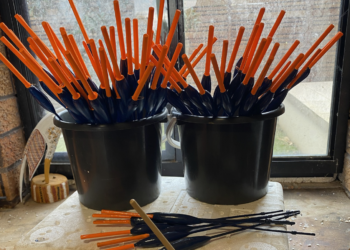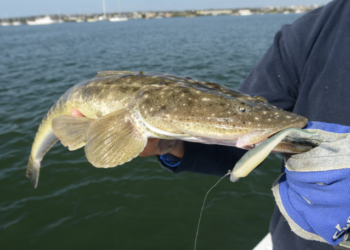Estuary Sportfishing
Catching whiting on poppers has been well documented but these scrappy estuary sportfish can also be targeted on other lures as well. BY RODERICK WALMSLEY.
SCENES involving skipping poppers, smashing hits and non-stop action would have the average person thinking of the Top End and queenfish, tuna or GT mayhem. Actually, this type of action can be experienced in any river that has a healthy population of whiting. Popper fishing for whiting has taken off in leaps and bounds since it became public knowledge in recent times and has showed many fishos out there that these little silver bullets are a very viable lure target. Small poppers have been labelled as the go-to lure, but as with any lure fishing it comes down to horses for courses. The more we target these wily estuary fish with lures, the more we realise that, as with bream, flathead or bass, choosing the right lure for the right occasion is the key to consistently catching your fair share of tasty, hard-fighting whiting.
Finding the fish
Whiting are synonymous with flats so the best place to find them is in relatively shallow water. Some flats fish better than others and seem to always hold good numbers of fish. What differentiates a good flat from an average one? Well, two main factors seem to remain constant: current and food. A flat that has good current flowing over it in relation to the rest of the waterway will almost always hold decent numbers of whiting. Obviously some waterways have more current than others. A flat located in the Tweed River, for instance, would obviously experience a lot more current than one situated in Lake Macquarie.
Whiting move up onto flats for one reason: to feed. It stands to reason, then, that a flat loaded with yabby holes is a very good place to start looking for fish. This is a top way of working out which parts of the flats hold the best fish. On a recent whiting trip on the Tweed we noticed this first hand. Every time we did a drift over a specific flat we found the fish seemed to be holding in two main areas. On closer inspection we found that both of these spots were loaded with yabbies.
Corrugations or channels/gutters are places that the fish can use to traverse the flats and also areas that the whiting can hold out of the current. These are absolute hot spots and if you come across a flat with these depressions in it always pays to work them over with your lures very thoroughly.

Timing
Whiting will move up onto a flat as soon as there is enough water for them to swim in. They’ve generally spent the low tide holding in the deeper water in anticipation of the run-in tide. This means that on the start of the run-in they will be in a very aggressive mood and hit lures noticeably better than at a later stage in the tide. As the tide progresses, the water clarity increases significantly and although you do still catch them you will often experience more follows or short strikes than during the earlier stage of the tide. As the tide starts to run back the water clarity starts to deteriorate and there is often a good bite period before the bite once again slows. This may sound strange but bream also become a bothersome by-catch on the run-out tide and often attack the lures in swarms. They’re good fun but if you’re specifically targeting whiting then they can be frustrating.
On the flip side, if you fish a river system that is exceptionally clear the fish will often be extremely spooky and may feed better on the run-out tide when the water becomes slightly discoloured.
If you have a waterway with several good flats situated throughout the system you can actually chase the tide with a “run and gun” technique fishing the prime bite period until the tide has well and truly run out.

Lure selection
Poppers were the lure style that initially started the hype surrounding actively targeting whiting with lures. Before this whiting on lures were regarded as a by-catch while targeting other species. Poppers do work and are still probably the go to lure, but they aren’t the only lure that will catch whiting. There are other lures that can out shine a popper no matter how well it is worked across the surface. The conditions that you are fishing in influence lure selection. Choosing the correct lure for the given situation will often be the difference between a half hearted follow or a crunching hit. Let us go through the different lures that are effective whiting catchers.
Surface walking stick baits: These are floating lures that can be worked across the surface with a “walk the dog retrieve”. There are a host of brands on the market and we all have our favourites. The thing that makes these lures so popular is their effectiveness in calm conditions. They have a subtle action that doesn’t spook fish when the surface of the water is flat. If the fish are responding well to a faster retrieve, stick baits can be skipped enticingly across the surface. When retrieved like this, they almost perfectly simulate a scurrying prawn. We have noticed a very positive hook up to bite rate on these lures and will often tie one of them on before a popper.
Sinking stick baits: If the top water lures seem to be getting a lot of interest but the fish are failing to commit, then it’s time to tie on a sub-surface stick bait. These are basically a sinking version of the surface walkers. The only difference is that they “walk the dog” under the water. They are generally very sensitive to hook size and can often be made to suspend or sink depending on hook size and leader type (an important point to note here is that fluorocarbon sinks and most monofilaments float). Fitting them with smaller light gauge hooks will cause them to suspend or float; similarly, heavier gauge over size hooks will make them sink. If chop on the water makes it difficult for the whiting to hit the surface lures, then this is when the sinkers come into their own.
Poppers: These lures create a lot of disturbance and can call fish in from a long way if they are actively feeding, but if the fish are a bit on the skittish side or the water is very flat they can often spook wary fish. Generally, poppers perform at their best when there’s a bit of surface chop. Rear hooks with a bit of hackle tied onto them can add to the attraction of the lure and also help the popper run a bit straighter to stop the front treble catching on the leader. Another trick to stop the front hook tangling is to use a short piece of thicker leader material. This “stiffer” leader also helps the lure track straighter and the fish can grab hold of the lure better. Poppers with smaller cup faces often perform better as they can be worked across the surface with a “spitting” retrieve instead of a deeper blooping cadence. Another trick one can use to help the popper skip is to file the lower section of the cup slightly so that it doesn’t grab as much water on the retrieve. This stops the popper from diving under the surface.
Minnows: These also catch whiting, although are often not used as much as the surface varieties, simply because they are not as visually exciting. Shallow running minnows are the gun lures. You’ll generally be fishing in super shallow water so even the shallowest varieties will often be banging into the sand. This really stimulates the whiting into biting. The by-catch with minnows is often greater than with the other lures.

Retrieves and Tackle
When fishing with these lures for whiting there is generally one type of retrieve that works – and that’s a constant one. The lure needs to be moving across or under the surface with a constant motion. On the odd occasion you can throw in a small pause before continuing the retrieve. This will often get a following fish to commit, as it has to decide whether to grab the lure or run into it. The pause must only be very slight, as whiting seem to shy away from the lure if they get a good look at it. It will pay to play around with retrieval speeds when using the different lures as on certain days the fish will react differently and will commit better to a faster or slower retrieve. If there are two of you fishing always try different lures to see which model is getting the best interest.
Whiting are not overly hard on tackle and even the bigger models don’t often pull much drag. Fishing as light as possible will help you to cast the often small lures further as well as enjoying the spirited fight from the fish. Long casts are the key to catching these fish so a rod longer than 6’6 is a must. Small threadline reels with light braided lines to aid casting and light leaders is basically all you will need to get amongst the fish. Wether you are land-based or fishing from a boat all you require is a few lures, a spool of leader line and you can be fishing in no time. Be warned, though: as small as some of the whiting may be, this type of fishing is great fun and you will be hooked once you have done it and experienced their explosive surface strikes.





















